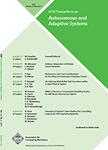版权所有:内蒙古大学图书馆 技术提供:维普资讯• 智图
内蒙古自治区呼和浩特市赛罕区大学西街235号 邮编: 010021

作者机构:Univ Libre Bruxelles IRIDIA Brussels Belgium Ecole Polytech Fed Lausanne STI ASL LSAI2S CH-1015 Lausanne Switzerland
出 版 物:《ACM TRANSACTIONS ON AUTONOMOUS AND ADAPTIVE SYSTEMS》 (ACM自控适应系统汇刊)
年 卷 期:2006年第1卷第2期
页 面:115-150页
核心收录:
学科分类:08[工学] 0812[工学-计算机科学与技术(可授工学、理学学位)]
基 金:European Commission [IST-2000-31010] Belgian FNRS ANTS project Scientific Research Directorate of the French Community of Belgium
主 题:Algorithms Swarm robotics evolutionary robotics self-assembly artificial neural networks evolutionary algorithms swarm intelligence
摘 要:This article illustrates the methods and results of two sets of experiments in which a group of mobile robots, called s-bots, are required to physically connect to each other, that is, to self-assemble, to cope with environmental conditions that prevent them from carrying out their task individually. The first set of experiments is a pioneering study on the utility of self-assembling robots to address relatively complex scenarios, such as cooperative object transport. The results of our work suggest that the s-bots possess hardware characteristics which facilitate the design of control mechanisms for autonomous self-assembly. The control architecture we developed proved particularly successful in guiding the robots engaged in the cooperative transport task. However, the results also showed that some features of the robots controllers had a disruptive effect on their performances. The second set of experiments is an attempt to enhance the adaptiveness of our multi-robot system. In particular, we aim to synthesise an integrated (i.e., not-modular) decision-making mechanism which allows the s-bot to autonomously decide whether or not environmental contingencies require self-assembly. The results show that it is possible to synthesize, by using evolutionary computation techniques, artificial neural networks that integrate both the mechanisms for sensory-motor coordination and for decision making required by the robots in the context of self-assembly.